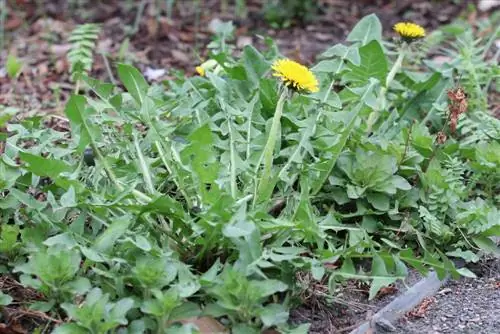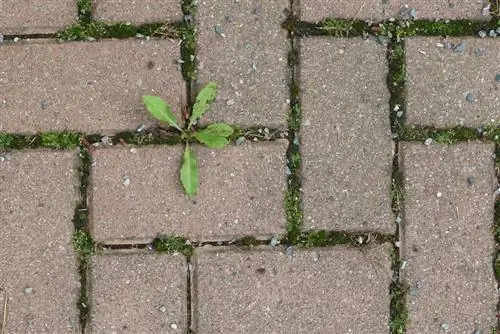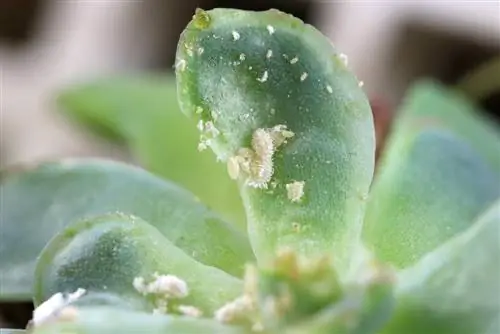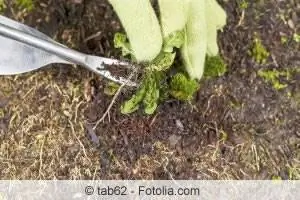- Author admin [email protected].
- Public 2023-12-17 03:39.
- Last modified 2025-01-24 12:45.
Whether it's a driveway, sidewalk or even patio, in places where there are joints or a sidewalk has been covered with gravel, unsightly weeds form over time and make the area appear unkempt. If you want to take sensible action against this, you can choose between various effective means of removing the weeds. S alt and vinegar is at the top of the list for many people. But other environmentally friendly means have proven successful.
S alt
S alt is definitely the best way to remove weeds from the joints of sidewalks, along with chemical mace. But this process is by no means an environmentally friendly solution. If you still want to use s alt to combat the weeds, you should proceed as follows:
- Make saline solution
- 10% s alt, the rest water
- pour the solution into the affected joints
- the s alt is absorbed by the weeds
- Fluid is withdrawn
- Weeds die off
- the roots are also completely destroyed
- Joints remain weed-free for as long as possible
S alt is controversial because it penetrates the ground and changes the conditions of the groundwater and the earth. In addition, s alt is prohibited for use against weeds on sidewalks, driveways or terraces; this is regulated in Section 6 of the Plant Protection Act. The violation, if discovered, can result in heavy fines.
Tip:
Especially when trees line the path, it is better not to use s alt to kill weeds. Because here it is the same as when sprinkling s alt in winter. The trees absorb the s alt that has seeped into the earth through their roots, but many are not s alt-tolerant and could suffer major damage or even die.
Vinegar
Many hobby gardeners swear by removing and destroying weeds with vinegar. In contrast to using s alt or even a chemical club, vinegar is a little more environmentally friendly. But vinegar, like s alt, is also one of the substances banned by the Plant Protection Act and may not be used on areas not used for gardening. In this case, these areas also include the sidewalks. If you still want to use vinegar to combat the weeds in the joints, you must proceed as follows:
- Create solution
- mix one part vinegar and one part water
- inject into the joints
- the weeds are dying
- the roots are also damaged
- can then simply be plucked out
- then sweep it up with a broom
Tip:
Since when using vinegar, the weeds still have to be plucked out of the joints so that they look neat again, this plucking work can also easily be carried out after a rain. The vinegar solution can be dispensed with.

Scraping out
The most conventional and, above all, gentlest method of clearing the joints on garden paths is certainly scraping. In the past, the weeds were removed from the joints with a short joint scraper by laboriously crouching on one's knees, but today the work is made a little easier. However, it is heavy and not necessarily suitable, especially for very large areas. When scraping manually, the procedure is as follows:
- Always scrape out joints after rain
- Work can of course also be done during the rain
- the weeds are easier to remove when wet
- Use a joint scraper and joint brush
- scrape and brush the joints carefully
- sweeping up the weeds after work
- do not dispose of in the compost heap
- otherwise seeds can spread throughout the garden
- better put in a bag with residual waste
Tip:
So that you can work while standing, joint scrapers and brushes with a telescopic rod are now available. This can be adjusted to the appropriate length and is therefore gentle on the back.
Electric grout cleaners
If you have a long walkway and a large area, an electric joint cleaner is a good idea. Due to its features, this is, above all, easy on the back. The telescopic handle, which can be adjusted to the desired height, makes work much easier. The electric joint cleaner was designed so that weeds can be removed from every joint, no matter how small:
- Wire brush cuts off the weeds
- equipped with guide line and guide roller
- so the device stays in line
- the entire joint is cleaned like this
- Be careful with different stones
- not everyone is suitable for this cleaning
- the sidewalk could be scratched throughout
- so before starting work, find out whether the stones are suitable for this
Tip:
If you don't want to buy an electric joint cleaner because you only want to use it once, for example because the joints need to be completely closed after use, you can also rent such a device on a daily basis from a hardware store or garden store.
High-pressure cleaner

High-pressure cleaners are also a good way to clear weeds from sidewalks. Like many other garden machines, a high-pressure cleaner can be rented on a daily basis from well-stocked retailers. But since the device can be used in a variety of ways, it is worth purchasing. When working with the high-pressure cleaner, you should proceed as follows:
- Connect the device to a garden hose
- Wear rubber boots
- possibly also rainproof clothing
- the water can splash back from the surface
- hold the jet directly onto the joints
- The stones can also be cleaned directly
Depending on what kind of stone the walking slabs are, you should avoid using a high-pressure cleaner, as this could otherwise attack the substance of the stones and thus damage them.
Tip:
When working with a high-pressure cleaner, you should first make sure that there are no small children or pets nearby. If they are hit by the hard jet of water, it can be extremely painful and even cause hematomas. In the worst case scenario, the little ones will be thrown over with force.
Boiling water
A very profound but very effective home remedy for weeds in the joints is hot water. However, in very large areas, destroying weeds with hot water also means a lot of work. However, if you have the option of connecting the hose to a hot water access, you can also work on long walkways in this way. The hot water offers the following benefits:
- very environmentally friendly
- little effort required
- is poured directly into the joints
- the roots of the weeds are also scalded
- Plants die so permanently
- Any seeds are also rendered harmless in this way
- let dry
- Pull the plants out altogether afterwards
Weed Burner
Just like hot water, the weed burner works through heat. To do this, the joints are flamed down and the weeds are permanently destroyed along with their roots, so that nothing will grow between the joints for a long time. The procedure is as follows:
- burn out the joints with a gas burner
- be particularly careful when doing this
- the flamethrower can also damage other things
- for example other plants
- or the lights that line the garden path
Tip:
It is important to consider in advance whether the material of the sidewalk can withstand the flames. Because some laid stones are too sensitive to the high heat. In such a case, not only are the weeds removed later, but the sidewalk is also significantly damaged.
Chemical agents
According to the law, it is forbidden to use chemical agents on sidewalks, driveways or terraces. Because the chemical weed killers, no matter how simple it would be, can reach the groundwater with their harmful substances. So these cannot simply be used in your own garden. Anyone who is caught using chemical agents to combat weeds on the paths can expect a hefty fine.
Biological weed killer

It is better than the home remedies of s alt and vinegar or the chemical mace to use a biological weed killer. If you are afraid of the strenuous work with the various devices, you can also get a liquid, biological agent from specialist retailers. The procedure is then as follows:
- dilute according to manufacturer’s instructions
- apply into the affected joints
- Plants are completely destroyed
Tip:
The biological weed killer from the market is not prohibited and can also be used on all areas according to the Plant Protection Act.
Prevent weed growth
If you have to re-lay a sidewalk, you can also take long-term prevention here. A weed fleece is placed under the panels, which is available from well-stocked garden shops or a hardware store. This is simply cut to size and placed on the excavated path before the panels are placed. The fleece can of course also be laid out under terraces or an access path. If the joints are then filled with sand or gravel, the fleece is no longer visible. For existing paths without a fleece subsurface, there is another, permanent solution:
- Scrape out the joints thoroughly
- remove all weeds like this
- Use paving grout
- is simply swept into the joints with a broom
- resin-based, this is elastic
- very suitable for outdoor use
- No damage caused by frost
- no cracks form due to wetness
- Weeds no longer stand a chance
Tip:
Preventing weeds in this way is a good choice, otherwise they will grow back several times every year and have to be removed. Therefore, especially when creating paths or other areas, you should think about preventing this directly. Mainly because the fleece is a cost-effective method.






